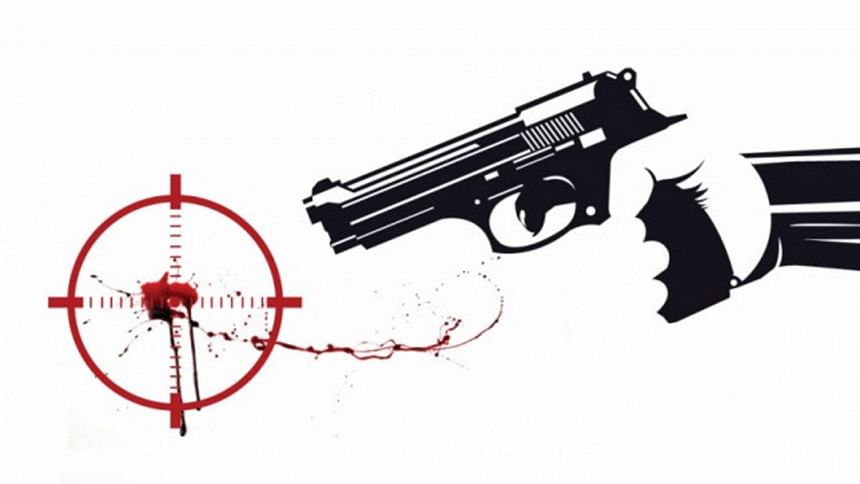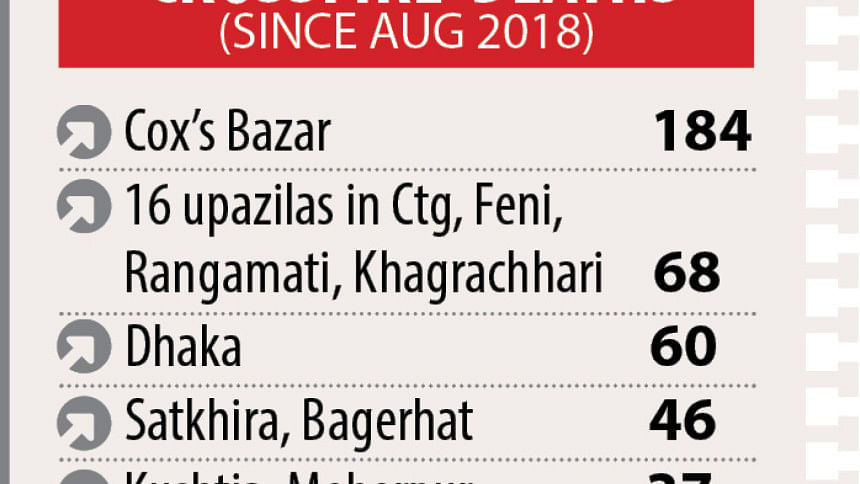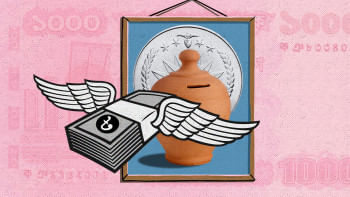‘Crossfires’, ‘Gunfights’ in Last 2 yrs: Body count high, not just in Teknaf


While all eyes are on the Teknaf police right now, it is imperative to remember that deaths due to "gunfights", "shootouts", and "crossfires" happen all across the country -- and that the numbers have skyrocketed since the war on drugs was announced in May 2018.
These deaths happen primarily at the hands of three agencies: the police, Rapid Action Battalion, and Border Guard Bangladesh.
There are 649 police stations, 61 BGB battalions, and 15 Rab battalions in total -- but reports published by The Daily Star between August 1, 2018 and August 1 this year show that just like the Teknaf police, some units are more complicit than others in this national crisis.
The death toll of no other district comes close to the number of people killed in so-called gunfights in Cox's Bazar, which includes Teknaf upazila, in the last two years -- 184 people to be exact, of which 87 was by just Teknaf police.
But no matter what the body count of a certain district may be, the majority of the deaths happened in "gunfights" with one or two prominent law enforcement units in the area.
Take Rab-7 for instance, which serves 16 upazilas in Chattogram, Feni, Rangamati, and Khagrachhari districts.
Between August 2018 and this month, this newspaper reported at least 68 deaths due to so-called gunfights in these upazilas -- giving this region the second highest death count after Cox's Bazar district -- 31 of which were by this one unit alone.
Most of the "shootouts" with Rab-7 happened in Banshkhali, with Sitakunda a close second.
For all of these "gunfights", the rhetoric broadcast by Rab-7 was almost unanimously this -- the law enforcers received a tip-off that criminals gathered at a certain spot, and when they arrived, the criminals sensed their presence, shot at them, forcing them to retaliate.
Specific details about how it happened are completely missing from all the interviews given by the Rab-7 commanders to this paper's journalists.
The rest of the deaths due to "gunfights" in the region happened with a handful of police stations such as Kotwali Police Station, Bayezid Bostami Police Station, Pahartali Police Station, and Khulshi Police Station, each of which is involved in the killing of one to three people in this two-year period.
The capital city and surrounding areas had a similar body count to that of Chattogram district, and according to this newspaper's reports, a vast majority of the deaths happened at the hands of Rab-1 and Rab-2.
Rab-1 was responsible for 17 deaths due to "shootouts" in this two-year period, while Rab-2 was responsible for 18.
In addition, 10 deaths happened at the hands of the Detective Branch of Dhaka Metropolitan Police. The rest were a smattering of police stations with one or two deaths each.
For some of these cases, this newspaper reported contradictory information to the elite force's explanation, including claims by families that the dead were picked up beforehand.
But one case stands out because of the sheer amount of evidence found.
Syed Iqbal Ahmed, 42, allegedly died in a "gunfight" with Rab-2 on January 12 this year in front of the Malibagh bus counters. The incident happened around 7:00am and the area was covered by CCTV cameras of various shops and businesses nearby -- but shopkeepers interviewed by The Daily Star said Rab officials came in and deleted the footage and didn't let anyone see what had been recorded.
When asked why Rab did this, the company commander at the time said they had collected the footage from the shops for investigation.
Satkhira, Bagerhat and the region around the Sundarbans, are other areas where deaths due to "gunfights" happened a lot -- most of which were at the hands of Rab-6 and Rab-8, as per The Daily Star reports.
At least 46 deaths due to this occurred in this region in the last two years.
This newspaper reported that at least 22 were killed in so-called gunfights with Rab-6 as the battalion raided secret meeting spots of criminals, while 18 died in encounters involving Rab-8.
All these incidents happened in the dead of the night, and usually beside some canals in the Sundarbans.
For example, on October 16 last year, 26-year-old Monish Saha was killed along with three others beside Koyra Khal at 2:00am.
Rab-6 special company commander, Tofazzal Hossain, then told this paper's correspondent that they raided the area at that time of night on a tip-off that robbers were staying there.
"Sensing our presence, the robbers entered the jungles of the Sundarbans and took position with arms. Then, they opened fire on the Rab team, forcing us to retaliate. The gunfight continued in several phases until morning. Some members of the gang fled the scene when day broke, leaving behind the four injured. The four were rushed to Koyra Upazila Health Complex where doctors declared them dead," said Tofazzal.
This was one of the rarer occasions where a family member of the dead spoke to this paper's correspondent.
Monish's brother Mithun claimed, "Some plainclothes policemen picked up my brother from our residence at Aichgati in Khulna's Rupsha upazila on October 1. On October 10, we informed Rab-6 about it. We came to know about his death as a robber of the Sundarbans today. But he was a small businessman."
Interestingly, while Rab almost unanimously reported getting attacked or ambushed, Satkhira Sadar Police Station, responsible for at least five deaths in the area, said they all happened due to "gunfights" between two rival gangs.
Meanwhile in Kushtia and Meherpur, the police are responsible for most of the deaths, similar to Teknaf. At least 37 deaths due to "gunfights" with the law enforcers were reported by this newspaper -- save for two, all of these involved police personnel.
In spite of the fact that there are nine upazilas in these two districts, each with many police camps and their own police stations, only three police stations reported most of these deaths -- Kushtia Model Police Station, Gangni Police Station, and Meherpur Sadar Police Station.
Almost consistently, the deaths were reported to have happened as a result of infighting between two gangs in the middle of the night, raising the question -- are there truly so many gang wars happening openly in the streets in these districts?
Most of the interviews given to the journalists by officers-in-charge is this: in the middle of the night, a gang war took place between two rival factions, the police rushed to the spot, the criminals ran away seeing the police, leaving behind a bullet-ridden body.
Similarly, in Jashore -- including Benapole -- 19 deaths due to "gunfights" with the law enforcers were reported by this newspaper, where all, save for two, were by the police. Of them, Jashore Kotwali Police Station reported the most deaths due to "gunfights".
Of these instances, two encounters by the Jashore Detective Branch were documented by this newspaper, and in both cases, this paper's correspondent reported that the victim was picked up before the "gunfight".
Jashore police also almost always reported that they "discovered" bullet-ridden bodies after hearing about a gang war, and going to the spot.
While the law enforcers sometimes claimed that their personnel too had been hurt, neither could this newspaper independently verify the claims nor were details ever provided about the exact nature of the injuries.
While "criminals" were killed in "gunfights" every other day during these two years, casualties among law enforcers was quite unusual.
Looking over news coverage during this period, it was found that The Daily Star recorded only one death of a law enforcer -- that of 45-year-old Havildar Akmol Hossain, from BGB Battalion-21, who was critically injured at a "gunfight" with suspected drug peddlers in Benapole, Jashore on June 26 last year.
Lt Colonel Imran Ullah Sarkar, commanding officer of BGB Battalion-21, told this paper's correspondent that Akmol and a team conducted a drive at Agrobhulot border area around 4:00am. Sensing the presence of the law enforcers, the drug dealers opened fire and hurled bombs towards the BGB team prompting them to retaliate, triggering a gunfight.
One person received mortal gunshot wounds, dying during the gunfight, while Akmol sustained critical injuries. He was shifted to Combined Military Hospital in the capital where he succumbed to his injuries three days later.
During their visit to Cox's Bazar, the police chief and army chief had said that Maj (retd) Sinha Rashed Md Khan's death in a police shooting was "an isolated incident".
But that's not what the numbers say.

 For all latest news, follow The Daily Star's Google News channel.
For all latest news, follow The Daily Star's Google News channel. 



Comments